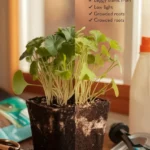When I planted a gorgeous hydrangea in my Zone 6 garden only to watch it die after one harsh winter. I learned the hard way: Gardening zones are not just a suggestion. They’re the key to understanding which plants can survive and thrive in your area. In this guide, you’ll learn how to decode these zones, avoid costly mistakes, and create a garden that flourishes year after year.
Part 1: What Are Gardening Zones?
Gardening zones, or hardiness zones, are geographic areas defined by climatic conditions, primarily based on average annual minimum winter temperatures. The most widely used system in the U.S. is the USDA Plant Hardiness Zone Map, updated in 2023 to reflect climate changes.
Key Features of the USDA Zone Map:
- 13 Zones: Ranging from Zone 1 (-60°F) to Zone 13 (70°F).
- Half-Zone Divisions: “a” (colder) and “b” (warmer) for precision (e.g., Zone 7a vs. 7b).
- Global Use: Canada, Europe, and Australia have similar systems (e.g., UK’s RHS ratings).
Why It Matters:
- Plant Survival: A Zone 5 plant (-20°F) will struggle in Zone 9’s mild winters.
- Guides Planting Schedules: Zones help determine frost dates and growing seasons.
Part 2: How to Find Your Gardening Zone

Step 1: Use the USDA Interactive Map
- Visit the USDA Plant Hardiness Zone Map.
- Enter your ZIP code for an instant result.
- Note your zone (e.g., “7b”).
Step 2: Understand Your Zone’s Challenges
- Cold Zones (1 – 5): Short growing seasons; focus on cold-hardy crops like kale and conifers.
- Temperate Zones (6 – 8): Ideal for most vegetables, roses, and perennials.
- Warm Zones (9 – 13): Year-round growing; perfect for citrus, palms, and tropical plants.
Pro Tip: Combine your zone with a heat zone map (e.g., AHS Heat Zone Map) to gauge summer stress on plants.
Part 3: Choosing Plants for Your Zone

1. Zone-Appropriate Plants
| Zone Range | Best Plants | Avoid |
|---|---|---|
| 3–5 | Lilacs, Peonies, Carrots | Avocado, Bougainvillea |
| 6–8 | Tomatoes, Hydrangeas, Lavender | Mango, Coconut Palm |
| 9–13 | Citrus, Hibiscus, Sweet Potato | Blue Spruce, Lilacs |
2. Reading Plant Tags
- Look for labels like “Hardy to Zone 5” or “Not recommended above Zone 9.”
- Example: A Japanese Maple labeled “Zones 5 – 8” will struggle in Zone 4 winters.
3. Exceptions and Microclimates

- Urban Heat Islands: Cities can be 1 – 2 zones warmer than rural areas.
- Sheltered Spots: South-facing walls or raised beds extend growing options.
Real-Life Hack: My Zone 6 friend grows figs by planting them against a sun-drenched brick wall (creates a Zone 7 microclimate).
Part 4: Common Zone Mistakes (And How to Avoid Them)
1. Ignoring Frost Dates
- Problem: Planting tender veggies too early.
- Fix: Use your zone’s last frost date (e.g., Zone 7: April 15) as a guide.
2. Overlooking Heat Tolerance
- Problem: A Zone 8 plant scorches in Zone 9 summers.
- Fix: Cross-reference with the AHS Heat Zone Map.
3. Misunderstanding Perennial Limits
- Problem: A “perennial” in Zone 7 may act as an annual in Zone 4.
- Fix: Research plants labeled “Tender Perennial.”
Part 5: Beyond the USDA – Other Zone Systems

- Sunset Climate Zones: Popular in the Western U.S., factors in humidity, elevation, and rainfall.
- Australian Hardiness Zones: Focus on tropical, subtropical, and arid regions.
- Europe’s RHS Ratings: Uses H1 – H7 ratings (H4 = -10°F to 5°F).
Global Gardeners: Use tools like Plantmaps for international zone conversions.
FAQ Section

Can I grow plants outside my zone?
Yes, but as annuals or in containers you can bring indoors (e.g., lemons in Zone 6).
Why did my zone change in 2023?
The USDA updated the map using 30 years of data, reflecting warmer temps in many regions.
How do zones affect fruit trees?
Most need “chill hours” (temps below 45°F). For example, apples require 500 – 1,000 hours, limiting them to Zones 4 – 8
What if my yard has multiple microclimates?
Use the warmest zone for tender plants and coolest for hardy ones. Track temps with a $10 soil thermometer.
Are zones useful for indoor plants?
Indirectly indoor climates mimic Zones 10 – 13 (tropical). Adjust humidity and light accordingly.
Conclusion: Your Zone is Your Gardening Superpower
Gardening zones aren’t about limiting creativity they’re about working smarter. By pairing your zone knowledge with microclimate hacks and the right plants, you’ll save time, money, and heartache.
Next Steps:
- Find Your Zone: Use the USDA tool and bookmark this guide.
- Audit Your Garden: Replace struggling plants with zone-appropriate alternatives.
- Experiment Safely: Try 1–2 “zone-pushing” plants each season (e.g., figs in Zone 6).


